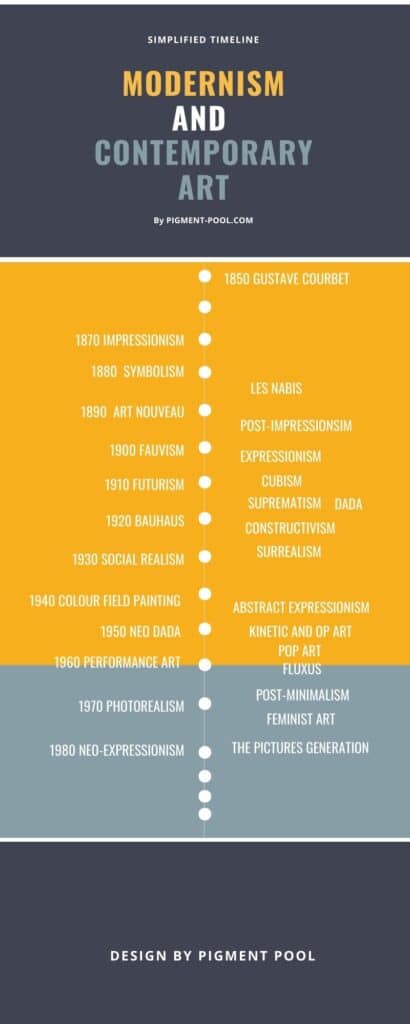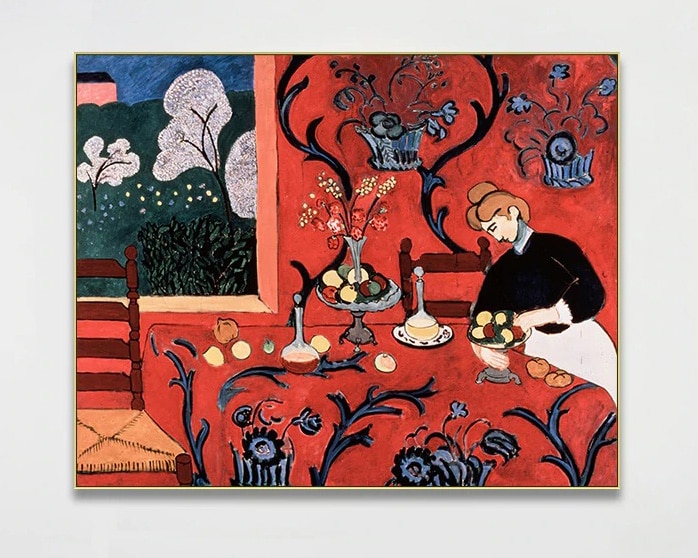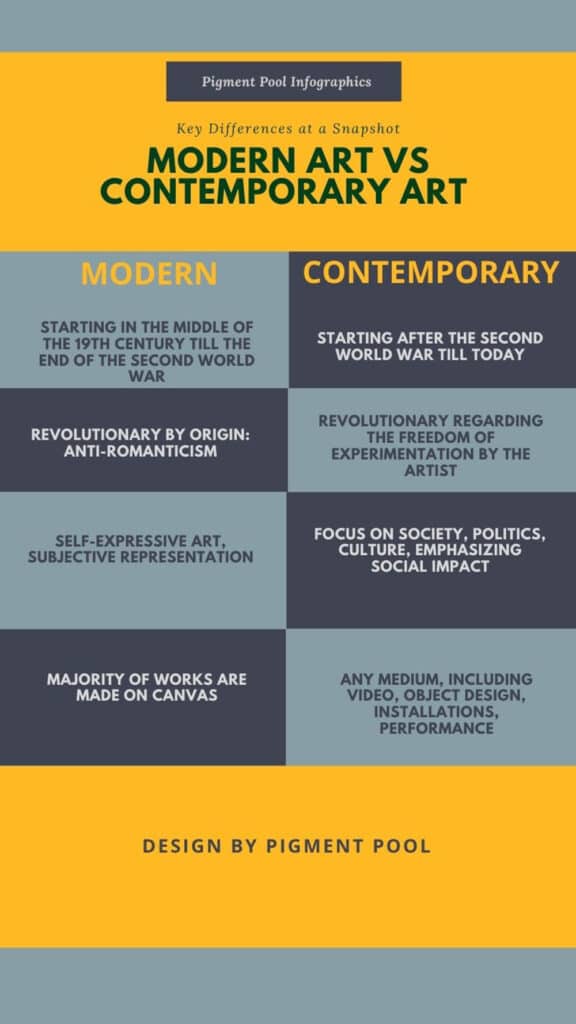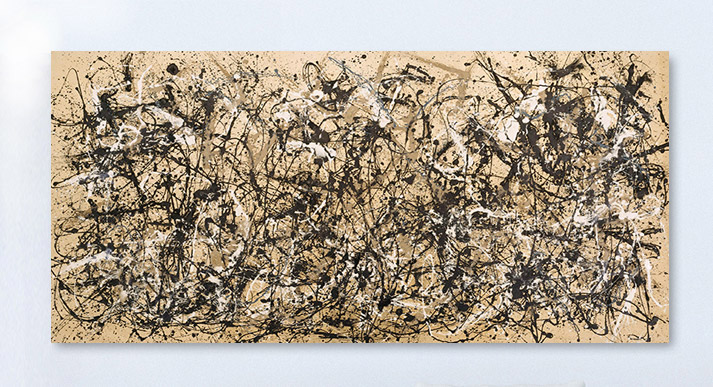- Big Bang: Gustave Courbet as Trailblazer for Modern Art
- Releasing the Shackles of Traditional Conventions in Art: The onset of Modern Art
- Manet as the Starting Point of Modern Art
- The -isms of Modernism
- The Transition to Contemporary
- What Does Contemporary Art Mean?
- The Role of Technology in Contemporary Art
- The Impact of Globalization on Contemporary Art
- Market Trends: Modern vs. Contemporary Art
- Conclusion
- FAQ
The terms “modern art” and “contemporary art” are often used interchangeably. Is there a difference between the two and if so, what do the terms refer to respectively? The first question is simple to answer: Yes, there is a difference, both regarding content and time of the two notions. The movements of modern art took place before the contemporary art period.
The second question, in how far modern and contemporary art are different, is trickier and can be answered in many ways. Some answers are straightforward and easy to grasp, others are more philosophical, relying on abstract conceptions. Let’s start with the short answer, which can be presented in a simplified timeline:
- Modern art is the period that started with the Impressionism art movement in the middle of the 19th century and that ended with the onset of Post-Modernism after the Second World War.
- Contemporary art is all forms of art that began after the Second World War and especially in the 1960s until today.

For a bit more elaborate answer, let us look at what was happening at these times starting with one decisive artist, Courbet.
Big Bang: Gustave Courbet as Trailblazer for Modern Art
Modern Art started with a big bang, which was a painting by Gustave Courbet called “Burial at Ornans”. What was different about this painting was that he portrayed the funeral of a common peasant man with unflattering realism in a giant scale, which was traditionally reserved for the religious or heroic scenes of the history painting genre. Courbet therefore established himself as an independent thinker, venturing beyond was constituted acceptable forms of traditional art by the state-run academies.

When Courbet exhibited his painting at the 1850 Paris Salon, it evoked an explosive reaction and brought Courbet instant fame. The Academy criticized the depiction of dirty farm workers around an open grave, lacking any sentimental rhetoric that had been expected in genre work up to that time. Critics accused Courbet of the deliberate pursuit of unattractiveness. Yet the public grew more interested in the artist’s realist approach and the decadent, lavish fantasy of Romanticism lost popularity.
Releasing the Shackles of Traditional Conventions in Art: The onset of Modern Art
Many people find it hard to make sense of modern and contemporary pieces of art. Before Courbet’s big ‘coming out’, art had been not perplexing at all since it was obvious to the viewer what art exemplified. The purpose of art had been clearly defined to be in service of history, religion, and politics. Art was mostly used to spread the ideology, the message, or tenets that they officially stood for. This becomes most obvious considering the fact that the large majority of ancient and classic art works in Europe show a prominent Christian influence, no matter if in paintings, sculptures, or in architecture.
Before the onset of modernism in the 19th century, art was still seen to serve political and religious causes. Beginning with Courbet, artists consecutively released themselves from the shackles of what had been considered legitimate art. Courbet’s motto, to only paint what he can see, became an important notion of what would be the movement of impressionism. The call for “art for art’s sake“, which is true from that time till today, marks the onset of the period of modern art. The main aim of modern art became setting aside the customary traditions of the past and focusing on a new approach in assessing the current issues of the world.
Manet as the Starting Point of Modern Art
While Courbet is considered a trailblazer of modern art, art critics such as Clement Greenberg consider Édouard Manet to have been the pioneer as the first modern artist, especially with his painting from 1863 “Luncheon on the Grass”. Not only did he depict scenes of modern life, but also did he break with tradition, discarding to mimic the real world using the means of perspective. The figures presented in the picture are not arranged according to the regular perspective but seem to be sitting on top of each other. Instead, Manet drew attention to the fact that he was painting on a flat canvas using a paintbrush – He deliberately left marks on the surface of his composition which shocked the critics at that time but inspired many artist generations to come to draw more attention to the medium used in painting.

The -isms of Modernism
The modernist art period began parallel to the dawn of the industrial revolution in Western Europe. The pace of life changed considerably with the invention of technologies such as machine-powered factories, electrical power generation, and the internal combustion engine in urban areas.
The advent of photography posed a serious threat to the classical modes of representing objects, since with painting artists impossibly could capture the same degree of detail. Painters tried to find new modes of expression, representing their experiences in the modern world in innovative ways. Their works became more personal and experimental.
Although modern art refers to a large number of artistic genres, including various terms ending with “ism”, spanning more than one century, the common denominator is the rejection of traditional styles and the artists striving to portray their subjects as they exist in the world aesthetically. The time gave rise to movements such as Impressionism, Fauvism, Post-Impressionism, Dadaism, Cubism, Surrealism, Expressionism, Pop Art, and many further art movements. Influential and famous modern artists were Paul Cézanne, Vincent Van Gogh, Pablo Picasso, Georges Seurat, Andre Derain, Henri Matisse, Henri de Toulouse, Piet Mondrian, Raoul Dufy, Maurice de Vlaminck, Pierre-Auguste Renoir, and Wassily Kandinsky.

The Transition to Contemporary
How did we get from modern art to contemporary art? Many art critics consider the movement of Abstract Expressionism as a turning point: Artists of this style focused less on the content of the picture and focused more on the process of making the artwork itself. Well-known examples are Jackson Pollock with his drip painting technique and Willem de Kooning, who also worked in a spontaneous improvisatory manner.

What Does Contemporary Art Mean?
Contemporary art literally means art of the moment, yet defining it in terms of a date range is challenging. What does ‘present day’ or art by ‘living artist’ really mean – terms that are often used in the context of contemporary art? Does it mean that a piece of art engages with the culture of the present day? These questions are negotiable and there is not definite answer to them.
Some art critics set the starting point of contemporary art to the end of the Second World War; others have the period starting in the 1970s. A central distinction between modern and contemporary art was the shift away from the aesthetic beauty of an art piece and towards the underlying concept of the work. The best examples for this new notion of art are performance art and conceptual art, in which the result is less important than the process of implementing art. Instead of beauty and form, contemporary artists of movements such as Pop Art, Minimalism, and Conceptual Art were often more interested in the concept behind the artwork and took on lots of different representational forms including video, installation, and performance.

For most contemporary artists, the actual piece of art or performance is not as important as the viewer’s impression of and experience through the artwork. Therefore, contemporary art often pushes the boundaries asking the question of what art can be.
The Role of Technology in Contemporary Art
Technology has greatly expanded the boundaries of contemporary art, offering new tools and mediums for creative expression. Digital media, such as graphic design software and 3D modeling, allows artists to explore virtual spaces, produce interactive art, and collaborate globally without being confined to traditional materials. This shift has opened up endless possibilities for how art is created and experienced.
AI is also revolutionizing the field, with artists using algorithms to generate unique compositions or works that respond to viewers in real time. AI-assisted art often challenges traditional notions of authorship, pushing the boundaries of creativity and innovation. Artists can program AI to evolve, creating dynamic pieces that adapt to external stimuli or changing environments.
Virtual reality (VR) adds another dimension by immersing audiences in fully interactive, 3D environments. Instead of simply viewing a piece, VR allows the viewer to engage with it spatially, creating deeply personal, immersive experiences. With VR, art transcends physical limitations, enabling artists to construct worlds and narratives that exist beyond the confines of the real world.
The Impact of Globalization on Contemporary Art
Globalization has broadened the scope of contemporary art, allowing artists from diverse cultures to engage with a global audience. As the world becomes increasingly interconnected, artists draw inspiration from multiple traditions and cultural experiences, blending styles and perspectives that transcend geographical boundaries. This fusion creates a rich tapestry of art that challenges traditional categorizations and allows for more inclusive representations of identity and heritage.
Incorporating diverse cultural perspectives into contemporary art has also allowed artists to address global issues such as migration, climate change, and social justice. By exploring these topics through a multicultural lens, contemporary artists create works that resonate with audiences worldwide. Artists no longer create in isolation, as technology enables them to collaborate across borders, exchanging ideas and techniques that enrich their creative processes.
Moreover, art institutions and galleries are increasingly showcasing works from underrepresented regions, giving a platform to voices that historically may have been marginalized. Globalization has also democratized access to contemporary art through online platforms, allowing artists from various backgrounds to reach audiences far beyond their immediate localities. This shift has led to a more diverse and inclusive contemporary art world, reflecting the complexities and interconnectedness of modern society.
Market Trends: Modern vs. Contemporary Art
The art market places significant value on both modern and contemporary works, but they are often approached differently by collectors and investors. Modern art, from movements such as Cubism, Surrealism, and Abstract Expressionism, typically holds historical significance, which often makes these pieces highly sought after by traditional collectors. Because of their rarity and established reputations, works from famous modern artists, like Picasso or Matisse, can command high prices and are viewed as stable investments.
In contrast, the contemporary art market is more fluid, with value often tied to emerging trends, cultural relevance, and the evolving reputations of living artists. Contemporary pieces can be unpredictable in their market performance, with some works gaining sudden prominence due to political relevance, social media exposure, or curatorial decisions. As a result, contemporary art is sometimes seen as more speculative, with collectors taking risks on new or lesser-known artists in the hopes of future appreciation.
Another difference in market trends is accessibility. While modern art is often exclusive and limited to established galleries or auctions, contemporary art is increasingly available through online platforms, making it more accessible to younger and international buyers. Contemporary collectors are also more likely to engage with digital art or mixed media, reflecting the growing interest in new technologies and experimental forms. This contrast between modern and contemporary art creates a dynamic marketplace with distinct paths for collectors.
Conclusion
In conclusion, the art market values both modern and contemporary works, though they are often approached differently by collectors. Modern art, with its historical significance and established reputations, is seen as a more stable investment, often commanding higher prices. On the other hand, contemporary art is driven by current trends and cultural relevance, offering more speculative opportunities but also greater accessibility, especially through online platforms. These distinct market dynamics create diverse opportunities for collectors, whether they seek stability in modern masterpieces or the potential of emerging contemporary artists.
FAQ
How are modern and contemporary art defined differently?
Modern art refers to works created roughly from the late 19th century until the mid-20th century, focusing on experimentation and abstraction. Contemporary art includes works from the mid-20th century to today, often addressing current social, cultural, or political issues. These timeframes and themes define each movement distinctly.
Why are modern art pieces generally more expensive than contemporary works?
Modern art is often more expensive due to its historical significance, limited availability, and the established reputation of its creators. Many modern pieces are from iconic movements and renowned artists whose works are rare. Contemporary art, while gaining value, is still tied to emerging trends and fluctuates based on the artist’s evolving career.
How do collectors approach contemporary art versus modern art?
Collectors often view modern art as a stable investment due to its historical value and limited supply. Contemporary art, on the other hand, is seen as more speculative, with collectors sometimes taking risks on emerging artists. The appeal of contemporary art lies in its relevance to current events and culture, offering potential for future appreciation.
What role do auctions play in valuing modern and contemporary art?
Auctions provide an important platform for determining the value of both modern and contemporary art. Modern art typically commands higher prices in auctions, driven by scarcity and the prestige of established artists. Contemporary art can see rapid price fluctuations depending on the artist’s popularity or current market trends.
Can contemporary art achieve the same historical significance as modern art?
While contemporary art reflects present-day issues, it can achieve historical significance over time as cultural relevance shifts. As new movements emerge, certain contemporary pieces may gain lasting importance, similar to how modern art movements evolved. The context in which these works are viewed may also shape their long-term value.
How does technology influence contemporary art compared to modern art?
Technology plays a significant role in contemporary art, with digital media, virtual reality, and AI being widely used in creative processes. Modern art, which predates these technologies, focused more on formal innovation using traditional mediums like oil paints and sculpture. The integration of tech in contemporary art reflects the digital age and expands creative possibilities.
Why is contemporary art considered more accessible than modern art?
Contemporary art is generally more accessible due to online platforms, virtual galleries, and affordable pricing for newer artists. While modern art is often housed in prestigious museums or private collections, contemporary works are widely available to a broader audience. This democratization of art has opened doors for younger and more diverse collectors.
What are the key movements within modern art?
Key movements within modern art include Impressionism, Cubism, Surrealism, and Abstract Expressionism. These movements broke away from traditional representation, focusing on abstraction, experimentation, and new perspectives. Each movement pushed the boundaries of what art could be, leading to the vibrant diversity seen in the modern period.
How does the art market value change between modern and contemporary artists?
Modern artists, having already established their legacy, typically maintain consistent market value, with their works steadily appreciating. Contemporary artists, however, experience fluctuating value, often influenced by current trends, gallery shows, and media attention. The future worth of contemporary pieces depends heavily on the artist’s evolving career.
What influences collectors to choose between modern and contemporary art?
Collectors of modern art are often drawn to its historical importance, rarity, and proven market value. Contemporary art appeals to collectors looking for innovation, cultural relevance, and the potential for growth in value as an artist’s career progresses. Each type offers unique benefits depending on the collector’s goals and interests.
You might also enjoy reading the following posts by Pigment Pool:
The Art of Hanging Art: How to Follow and Break Rules
This article may contain compensated links. Please read Disclaimer for more info. As an Amazon Associate, I earn from qualifying purchases.
